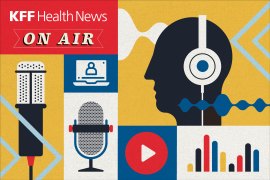After Medicaid Concessions, House GOP Hardliners Let Megabill Advance
The tax bill survived a committee vote Sunday night. It would make Medicaid work requirements happen "as soon as possible," House Speaker Mike Johnson said. The measure still faces uncertainty as it comes up for votes in the full House and the Senate. Plus, the effects this “big, beautiful bill” would have on health care providers and patients.
Bloomberg:
Trump Tax Bill Advances After Republican Hardliners Drop Blockade
A key House committee advanced President Donald Trump’s giant tax and spending package after Republican hardliners won agreement from party leaders to speed up cuts to Medicaid health coverage. The House Budget Committee approved the legislation late Sunday night after a weekend of negotiations with four ultraconservatives on the panel who on Friday joined with Democrats to reject the legislation. Those hardliners instead abstained on Sunday and voted present, allowing the bill to advance. (Birnbaum, Dillard, and Dennis, 5/19)
The Hill:
Health Experts Brace For Medical Coverage Losses From 'Big, Beautiful Bill'
Doctors, patients and health experts are bracing for massive coverage losses as House Republicans are poised to impose Medicaid work requirements as part of the “big, beautiful bill” encompassing many of President Trump’s legislative priorities. They are warning that a blizzard of red tape and administrative hurdles will strip people of needed health care. (Weixel, 5/18)
The New York Times:
As Congress Debates Cutting Medicaid, A Major Study Shows It Saves Lives
The expansion of Medicaid has saved more than 27,000 lives since 2010, according to the most definitive study yet on the program’s health effects. Poor adults who gained Medicaid coverage after the Affordable Care Act expanded access were 21 percent less likely to die during a given year than those not enrolled, the research shows. By analyzing federal records on 37 million Americans, two economists found that deaths fell not only among older enrollees but also among those in their 20s and 30s — a group often assumed to have few medical needs, and who would have been far less likely to qualify for Medicaid before the expansion. (Kliff and Sanger-Katz, 5/16)
Military.com:
Military Families Could Go Hungry Due To Food Assistance Cuts In GOP's 'Big Beautiful Bill'
Active-duty service members face food insecurity at higher rates than the civilian population. While about 25% of service members were considered food insecure in 2018 and 2020, just about 10% of civilian adults were food insecure in the same time period, according to a 2024 study from the U.S. Department of Agriculture. Congress has taken steps in recent years to alleviate food insecurity in the military, including approving a massive pay raise for junior enlisted troops that took effect in April and creating a new benefit called the Basic Needs Allowance for service members near the federal poverty line. But many military families rely on SNAP, more colloquially known as food stamps. (Kheel, 5/16)
ABC News:
'I Feel Very Scared': Some Americans Fear Losing Coverage Due To Proposed Medicaid Cuts
Key components of the bill to fund President Donald Trump's agenda looks to provide major tax breaks by cutting spending elsewhere, including massive cuts to Medicaid. Medicaid is a joint federal and state health insurance program for disabled and low-income Americans. The Centers for Medicare & Medicaid Services (CMS) works with state programs to administer Medicaid, under which more than 71.2 million people are enrolled. (Kekatos, 5/16)
KFF Health News:
Housing, Nutrition In Peril As Trump Pulls Back Medicaid Social Services
During his first administration, President Donald Trump’s top health officials gave North Carolina permission to use Medicaid money for social services not traditionally covered by health insurance. It was a first-in-the-nation experiment to funnel health care money into housing, nutrition, and other social services. Some poor and disabled Medicaid patients became eligible for benefits, including security deposits and first month’s rent for housing, rides to medical appointments, wheelchair ramps, and even prescriptions for fresh fruits and vegetables. (Hart, 5/19)
KFF Health News:
KFF Health News’ ‘On Air’: Journalists Unpack Drug Prices, Threats To Medicaid, And The Fluoridation Of Water
Céline Gounder, KFF Health News’ editor-at-large for public health, discussed the FDA’s phasing out of fluoride drops and tablets for children on CBS’ “CBS Mornings” on May 15. (5/17)
In related news —
The CT Mirror:
CT Officials Poised To Exceed Budget Cap To End Medicaid Crisis
State officials are poised to legally exceed Connecticut’s spending cap for the first time in nearly two decades to avert a crisis in paying Medicaid bills — and to pave the way for a new two-year budget. Both Gov. Ned Lamont’s administration and House Speaker Matt Ritter, D-Hartford, confirmed a tentative understanding to resolve the Medicaid shortfall expected to approach or exceed $300 million this fiscal year. (Phaneuf, 5/16)
NPR:
Unauthorized Immigrants Could Lose Health Care In States
Democratic governors in states offering health insurance coverage for immigrants without legal status are proposing to roll back coverage that they signed into law. As states grapple with budget holes, efforts to limit access to the programs are becoming a common thread. Debates about rolling back coverage or eliminating it entirely come as Congress considers a proposal that would reduce state Medicaid funds from 90% to 80% if they offer health insurance coverage to immigrants without proper authorization. (Ferguson and Fitzgerald, 5/18)
The Washington Post:
Families Of Disabled Children Frequently Struggle To Pay Medical Bills
Families of children with disabilities were nearly twice as likely to report financial hardships as families of those without disabilities, according to a recent study published in JAMA Network Open. Analyzing data for 22,670 children ages 5 to 17 from the 2019-2022 National Health Interview Survey, researchers recently found that some 22.3 percent of families with children who have disabilities experienced financial hardship. In comparison, about 12.6 percent of families with children who don’t have disabilities faced such difficulties. (Docter-Loeb, 5/19)






